Home
Aussie Bee Online
Welcome
New Articles
About Native Bees
Bee Photo Gallery
Bees in Your Area
Common Questions
Rescuing Native Bees
Exotic Bumblebees
What are Stingless Bees?
Buying Stingless Bees
Honey Production
Crop Pollination
Study Native Bees
Field Guide
Information Booklets
Tim Heard's Book
John Klumpp's Book
Aussie Bee Back Issues
Seminars
Links
Support Native Bees
Aussie Bee Shop
Order Form
Who We Are
Donations
Privacy Policy
Free Newsletter
Website Survey
Download Printer-Friendly PDF version of this article
Australian Survey of
Stingless Beekeeping: 2010
Dr Anne DollinAustralian Native Bee Research Centre
June 2013
In 2010 Megan Halcroft and Aussie Bee asked stingless bee owners across Australia to participate in a survey. The 637 beekeepers who responded gave fascinating details about the hives in their collections and the ways they were using their hives. Here are the major findings of this important survey.
|
Megan Halcroft posted the questionnaire for the 2010 survey on her www.beesbusiness.com.au website. She analysed the results as part of her PhD thesis and then published the results in the Journal of Apicultural Research (see below). Now that the formal requirements of analysis and publication of this survey are complete, Aussie Bee can bring you this Aussie Bee Online report on the results. Megan’s full report on this survey can be found in the following paper: Halcroft MT, Spooner-Hart R, Haigh AM, Heard TA and Dollin A. (2013) The Australian stingless bee industry: a follow-up survey, one decade on. Journal of Apicultural Research 52: 1-7. Copies of this paper are available from Megan’s Bees Business website. |
Australia’s first-ever survey of stingless beekeeping was conducted in 1999 by Aussie Bee and Tim Heard (see report in ANBRC Booklet 7). Megan’s 2010 survey was designed to assess the growth of the Australian stingless bee industry in the decade since the first survey.
As shown in the graph below, there were over twice as many beekeepers and over three times as many hives recorded in the 2010 survey, compared with the 1999 survey.
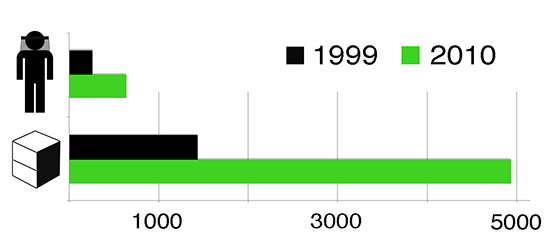 |
| A graph showing the great increase in the numbers of beekeepers and of hives recorded between 1999 and 2010 in our surveys. |
However, the 2010 survey did not, of course, cover every stingless bee owner in Australia. So Australia’s actual numbers of beekeepers and hives are even higher than these figures.
How Many Colonies are Kept in Boxes?
Beekeepers in the 2010 survey reported that 92% of their colonies were kept in hive boxes rather than in their original logs. In 1999 this figure was 82%. So more of our beekeepers are now using boxed hive techniques.
About 18% of beekeepers were making their own hive boxes in 2010. Most of these boxes had a design similar to the OATH style with an internal capacity of 7 to 10 litres.
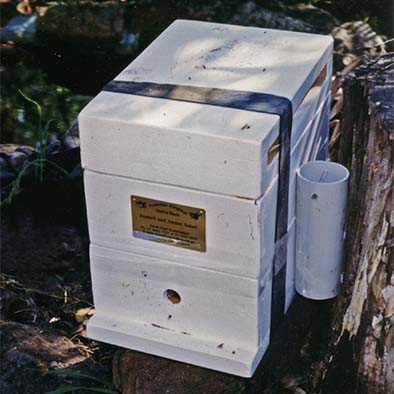 |
An OATH style hive belonging to Russell Zabel. |
What Species are Kept?
In the 2010 survey, the main stingless bee species being kept were:
-- Tetragonula* carbonaria (62%)
-- Austroplebeia australis (23%)
-- T. hockingsi (9%)
The remaining hives were reported to be T. clypearis, T. sapiens, T. davenporti or A. symei, or the beekeeper did not know the species name.
|
* Tetragonula is the new name for the Australian stingless bees that were previously called Trigona. More details. |
Over twice as many hives of A. australis were reported in the 2010 survey compared with the 1999 survey. Nearly all of the owners of these hives said they were keeping their hives for enjoyment. Austroplebeia colonies do not cover their nest structures with resin layers as much as Tetragonula colonies do, so they make particularly attractive observation hives.
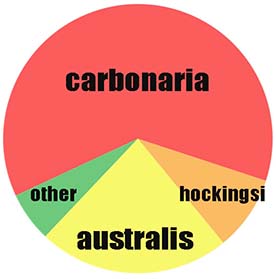 |
Stingless bee species kept by beekeepers in 2010 |
Where Do Our Beekeepers Live?
In 1999, 70% of our beekeepers lived in Queensland and only 28% lived in NSW. In 2010, however, interest in keeping stingless bees was spreading southwards with just 61% of beekeepers living in Queensland and 38% in NSW.
Conservation programs run by a number of councils in Sydney are contributing to this growth in NSW. For instance, Peter Clarke said that the WildThings program of Ku-ring-gai Municipal Council in Sydney supplied 185 hives of T. carbonaria to local residents over six years. These programs encourage residents to protect and understand their local wildlife.
Most beekeepers (63%) in 2010 lived in suburban areas, up from 56% of beekeepers in 1999. However, Megan estimated using Google Earth maps that 41% of these suburban beekeepers had some type of native bushland within 500 metres.
How Many Colonies do our Beekeepers have?
In 2010, most beekeepers (57%) owned just one hive but 35 beekeepers had more than 20 hives, four owned between 100 and 200 hives, and five owned more than 200 hives each. The highest number of hives reported by a beekeeper was 476.
Fairly similar hive ownership numbers were reported in the 1999 survey -- see graph below.
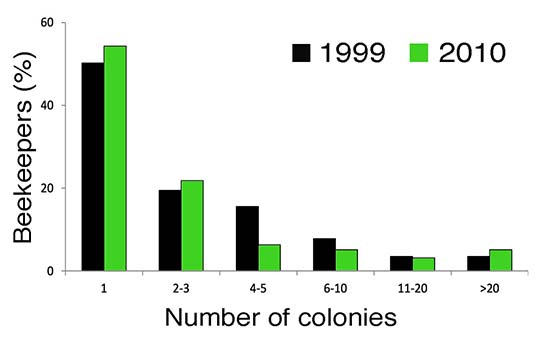 |
How Experienced are our Beekeepers?
Most of our beekeepers are still newcomers. In both 2010 and 1999 about half of our beekeepers had three years or less experience -- see graph below.
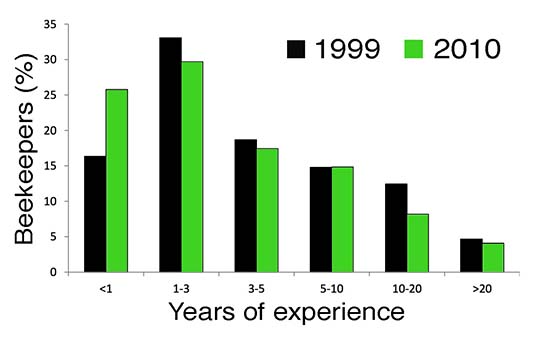 |
Transferring colonies into boxes was the most common hive manipulation done in 1999. However, in 2010 the most common manipulation was splitting hives. This is pleasing as it suggests that more beekeepers are building up their collections now by splitting hives, rather than removing new nests from trees.
Splitting hives is a more sustainable method of propagation in the longterm. However, it is important to remember that many of the new nests obtained by our beekeepers have been rescued. For instance, they come from felled trees, which would otherwise have been burned, in landclearing operations.
Why are Stingless Bees being Kept?
The reasons why people were keeping stingless bees were quite similar in both 1999 and 2010. The 2010 figures are given in the following comments.
The great majority of beekeepers were keeping stingless bees for the enjoyment of watching them (78%) and to help conserve the bees (67%).
About 29% of beekeepers kept bees to help pollinate bushland but 24% of beekeepers were using their bees for crop pollination. The crops on which the bees were being used in 2010 were macadamia, lychee, watermelon, avocado, blueberry and mango. However, only four beekeepers reported charging fees for their pollination services. This is an area where further research could lead to a substantial expansion of the Australian stingless bee industry in the future.
About 11% of beekeepers were producing honey with their bees. In 2010, 63 beekeepers said they were harvesting stingless bee honey. However, only five of these beekeepers were selling the honey they produced. They were selling their honey through local markets, to restaurants, or on the internet, and two producers were exporting stingless bee honey to Japan.
Our current production of stingless bee honey (<300 kg per year) is very tiny compared with the 27,800 tonnes produced by commercial European honeybees in Australia. However, stingless bee honey, known as ‘Sugarbag’ is a niche product that demands a high price: Tim Heard said the current retail price is about $140 per kg.
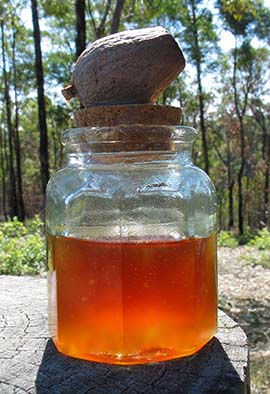 |
Tangy Sugarbag honey from Australian stingless bees |
Most beekeepers used T. carbonaria for honey production, though a small number used T. hockingsi or A. australis. Only beekeepers living in Queensland reported producing more than one kg of honey per year. This supports the view that these tropical stingless bee species are only suitable for honey production in warm northern areas of Australia.
About 3% of beekeepers were selling hives of stingless bees. In 2010, our beekeepers reported selling more than 460 hives per year -- four times more than in 1999. According to Russell Zabel and Tom Carter, the retail price of a strong stingless bee colony has doubled in the last ten years, from $200 to about $400.
Other reasons for keeping stingless bees in 2010 included education (12%) research (4%) and production of resin and wax (2%).
Conclusion
The Australian stingless bee industry has grown substantially since the first survey in 1999. However, it is still small in comparison with stingless bee industries overseas. Currently demand from customers wishing to purchase hives and stingless bee honey is very high and this is exceeding supply.
The use of stingless bees for crop pollination is continuing to develop and good results are being reported. However, the number of beekeepers providing professional pollination services is extremely small and there is also much scope for growth in this sector of the industry.
Further Reading:
Heard TA and Dollin AE (2000) Stingless bee keeping in Australia: snapshot of an infant industry. Bee World 81: 116-125.
Halcroft MT, Spooner-Hart R, Haigh AM, Heard TA and Dollin A. (2013) The Australian stingless bee industry: a follow-up survey, one decade on. Journal of Apicultural Research 52: 1-7.
| Megan Halcroft and Aussie Bee warmly thank all the beekeepers who so generously gave their time to participate in the 2010 survey!
With your help, we have gained a valuable overview of the Australian stingless bee industry in 2010. |
(If you have not used PDF before, click here.)
• For more interesting Aussie Bee Online articles on native bees, visit the contents
Author: Anne Dollin
(See Anne Dollin's Google+ profile)
.
|
Please feel free to print out this article or to email copies of the PDF version to your friends. This article may also be reproduced or hosted on other websites providing it is kept in its full and unaltered form including ANBRC contact details.
|
.
Search Aussie Bee Website:
© 1997-2018 Australian Native Bee Research Centre
PO Box 74, North Richmond NSW 2754, Australia